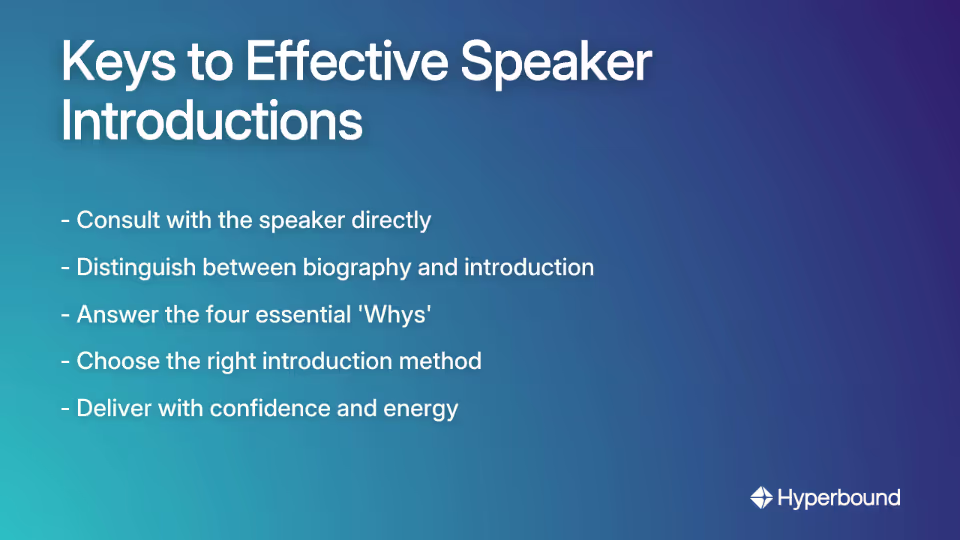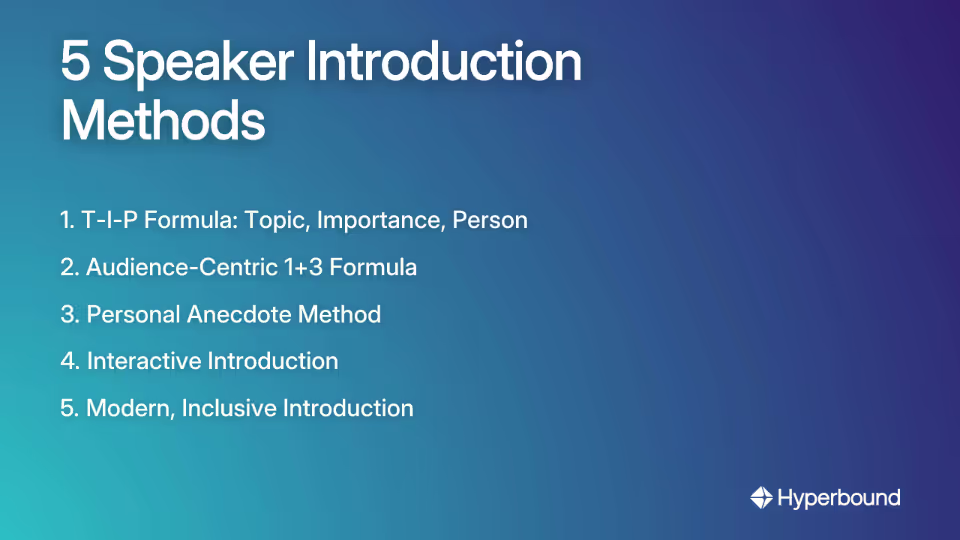
You've been asked to introduce a speaker at an upcoming event. Now you're staring at a blank page, wondering how to craft an introduction that doesn't sound like a boring resume recitation or create an awkward moment for everyone involved.
Whether you're introducing a keynote speaker at a conference, a guest lecturer for your class, or a presenter at a community event, this critical moment sets the tone for the entire presentation. A great introduction isn't just a formality—it's your opportunity to build credibility, focus the audience, and create anticipation for what's to come.
In this guide, you'll discover five proven methods for introducing speakers, complete with templates and scripts you can customize for any occasion. Say goodbye to awkward, rambling introductions and hello to confident, engaging speaker setups that serve both your audience and your presenter.
The Foundation of a Flawless Introduction: Preparation Is Key
Before you craft a single word of your introduction, you need to lay the groundwork. The most polished delivery can't compensate for poor preparation.

The Golden Rule: Consult the Speaker First
Your first step should always be to connect with the speaker directly:
- Ask for preferences: Many experienced speakers already have a crafted introduction they know works well. Always ask if they have a preferred introduction before creating your own.
- Confirm pronunciation: Nothing undermines an introduction like mispronouncing the speaker's name. Ask them directly and, as suggested by Leadr, request a voice memo if you're uncertain.
- Normalize pronouns: Make asking for pronouns a standard part of your preparation process. This removes awkwardness and ensures respectful representation.
- Identify key points: Ask which credentials, accomplishments, or topics they want emphasized—and understand why these points matter to them and the audience.
A Biography Is NOT an Introduction
This crucial distinction is often overlooked. As Expert MC emphasizes, your job as an emcee isn't to read a CV—it's to build a bridge between the speaker and the audience.
If a speaker provides a lengthy biography or one with an unusual tone, you have options:
- Thoughtfully edit it down to the most relevant points
- If using their exact language feels uncomfortable, frame it explicitly with phrases like "In her own words..." or "As he puts it..."
This approach respects the speaker's preferences while freeing you from feeling responsible for content you didn't create.
Answer the Four "Whys"
Before writing your introduction, answer these four essential questions that will structure your thinking:
- Why this Subject? What makes this topic compelling right now?
- Why this Speaker? What unique authority do they bring to this specific subject?
- Why this Audience? How does this topic connect to this audience's needs or interests?
- Why Now? What creates urgency or immediate relevance?
With this foundation in place, you're ready to craft a compelling introduction using one of these five proven methods.
5 Proven Ways to Introduce a Speaker

Way 1: The Classic T-I-P Formula (Topic, Importance, Person)
This straightforward structure answers the key questions your audience needs addressed: What's this about? Why should I care? Who's qualified to speak on it?
T - Topic: Start by introducing the subject, using a hook to grab attention.
- Ask a thought-provoking question: "Have you ever wondered how a single social media post could completely transform your business?"
- Share a surprising statistic: "Did you know that 68% of Americans make purchasing decisions based on social proof before ever speaking to a sales representative?"
I - Importance: Explain why this topic matters specifically to this audience. Connect it directly to their challenges, goals, or the event's purpose.
P - Person: Now introduce the speaker, highlighting their relevant credentials and expertise. Build anticipation by saving their name for last.
Sample Script:
"Good morning! In today's digital marketplace, the ability to create content that actually engages your audience is the difference between thriving and merely surviving. This challenge affects every business in this room, regardless of your industry or size. Our next speaker has helped over 200 companies triple their engagement rates using her proprietary framework. She's advised Fortune 500 companies, written the bestselling book 'Content That Converts,' and maintains one of the most-followed industry blogs on this topic. Please join me in welcoming our expert on strategic content creation, Sarah Johnson!"
Way 2: The Audience-Centric 1+3 Formula
This powerful technique from Devon Brown shifts focus from the speaker's past to the audience's future benefits.
The structure is simple but effective:
- The ONE Big Thing: A single, compelling sentence that answers "What's in it for me?" for the audience
- The THREE Qualifications: Three specific, relevant points of credibility that prove the speaker can deliver on that promise
Sample Script:
"Our next speaker is here to show you exactly how to double your client retention rates in the next 90 days without hiring additional staff. He's not just sharing theories—he's implemented these strategies in over 50 small businesses just like yours, his methods have been featured in Entrepreneur and Forbes, and today he's giving you the exact same blueprint his private clients pay thousands for. Please help me welcome, Michael Chen!"
Notice how different this feels from a typical biography-based introduction. It's entirely focused on what the audience will gain.
Way 3: The Personal Anecdote
This method creates a warm, human connection by sharing a brief, genuine story about the speaker or their work.
Sample Script:
"Good evening, everyone. When I first encountered Dr. Rivera's research on sustainable architecture, I was skeptical that one design approach could simultaneously address climate concerns, reduce costs, and improve aesthetics. Then I visited one of her building projects in Seattle. The transformation was so remarkable that I immediately invited her to speak with us today. Her expertise in environmental design has influenced projects across three continents. Please join me in welcoming Dr. Sophia Rivera, who will be sharing her groundbreaking approach to urban sustainability."
Important tip: Keep the story brief and make the speaker the hero, not yourself. Your personal connection should serve to elevate their expertise, not showcase your own.
Way 4: The Interactive Introduction
Get the audience engaged from the very beginning with this technique that makes them active participants before the speech even starts.
Sample Script:
"Hello, everyone! Before I introduce our next speaker, I'd like you to raise your hand if you've ever struggled to find qualified candidates for open positions. [Pause for response] Now, keep your hand up if this challenge has cost your organization money or opportunities in the past year. [Pause again] Our next speaker, Taylor Washington, has dedicated the past decade to solving exactly this problem. As the founder of TalentBridge and author of 'The Hiring Revolution,' Taylor has helped companies reduce their hiring time by an average of 37%. Please welcome to the stage, Taylor Washington!"
This approach immediately connects the audience to the topic through their own experience, making them more receptive to the speaker's message.
Way 5: The Modern, Inclusive Introduction
This method addresses one of the most common concerns in contemporary introductions: how to handle pronouns naturally and respectfully.
The key is to weave, not state. Rather than awkwardly announcing pronouns, incorporate them naturally into your narrative flow:
Sample Script:
"Our next speaker is Alex Martinez, a pioneer in digital accessibility. They have advised over 100 organizations on creating truly inclusive online experiences for all users. In their bestselling book, 'Design for Everyone,' they outline principles that have become industry standards. Their work has been recognized with multiple innovation awards, and we're fortunate to have them with us today. Please welcome Alex Martinez!"
This approach normalizes pronoun usage while keeping the focus on the speaker's expertise and value to the audience.

The Delivery: Sticking the Landing
Even the best introduce speaker template can fall flat with poor delivery. These final tips will help you nail your presentation:
Be Energetic and Welcoming
Your energy sets the tone for the entire presentation. The Speaker Lab emphasizes the importance of smiling and showing genuine enthusiasm. If you seem bored or disengaged, the audience will follow your lead.
Keep It Brief
A great introduction is impactful but concise. Aim for under two minutes to maintain audience attention. As Expert MC notes, "The audience came to hear the speaker, not the introducer."
Lead the Applause
As you announce the speaker's name, begin clapping to set the energy level in the room and encourage the audience to join in. This creates momentum and a warm welcome.
The Graceful Handoff
Stay at the lectern until the speaker arrives, greet them with a handshake or nod, and only then move away. This prevents an awkward gap and shows respect. The physical handoff should be as smooth as your verbal one.
Practice, Practice, Practice
Rehearse the introduction until it feels natural. If possible, practice with the actual microphone and in the venue where you'll be speaking. Tools like Hyperbound can help you identify filler words and improve your delivery through AI-powered feedback.
Speaker Introduction Templates: Quick Reference
For your convenience, here are condensed templates for each introduction style:
T-I-P Formula Template
[Introduce TOPIC with a hook]
[Explain the IMPORTANCE to this specific audience]
[Introduce the PERSON, highlighting relevant credentials]
"Please join me in welcoming [Speaker's Name]!"
1+3 Formula Template
"Our next speaker is here to show you [ONE big benefit to audience].
They've [Qualification 1], [Qualification 2], and [Qualification 3].
Please help me welcome, [Speaker's Name]!"
Personal Anecdote Template
"[Brief personal story connecting you to the speaker or their work]
[Transition to their relevant expertise]
[Connect to today's topic]
Please welcome [Speaker's Name]!"
Interactive Template
"[Question that engages audience in a show of hands]
[Follow-up question or observation]
[Connect questions to speaker's expertise]
Please welcome [Speaker's Name]!"
Modern Inclusive Template
"Our next speaker is [Name], a [role/title].
[Sentence using their pronoun]
[Another sentence using their pronoun]
Please welcome [Speaker's Name]!"
Conclusion: You're More Than an Announcer, You're an Ambassador
A great introduction is never improvised. It requires thoughtful preparation, consultation with the speaker, and a clear focus on what the audience needs to know.
Your role isn't simply to announce a name—it's to build a bridge of credibility and anticipation. By moving beyond the biography and using one of these proven methods, you transform a simple announcement into a powerful endorsement.
Choose the introduction style that best fits your event, audience, and speaker. Practice it until it feels natural. Then approach your next introduction with confidence, knowing you're setting the stage for success.
Remember that with each introduction, you have the opportunity to create a meaningful moment that serves both your speaker and your audience. It's not just about following a template—it's about making a genuine connection that enhances the entire event experience.
With these tools in your toolkit, you're well-equipped to introduce any speaker with confidence and professionalism. Your audience—and your speakers—will thank you.
Frequently Asked Questions
What is the most important part of introducing a speaker?
The most important part of introducing a speaker is preparation, especially consulting with the speaker directly. Before writing your introduction, always ask the speaker for their preferences, confirm the pronunciation of their name, clarify their pronouns, and identify the key accomplishments they want highlighted. This ensures your introduction is accurate, respectful, and aligned with their goals.
How long should a speaker introduction be?
A speaker introduction should be brief and impactful, ideally lasting under two minutes. The purpose of the introduction is to build credibility and anticipation for the main speaker, not to be a speech in itself. A concise introduction respects the audience's attention and ensures the focus remains on the person they came to hear.
What should I do if a speaker's provided biography is too long or awkward?
If a speaker provides a biography that is too long or doesn't fit the event's tone, you should not read it verbatim. Your role is to build a bridge, not recite a CV. Thoughtfully edit the bio down to its most relevant and impactful points. If you must use their specific wording, frame it by saying, "In their own words..." to separate their voice from yours.
How can I make a speaker introduction more engaging for the audience?
To make an introduction more engaging, shift the focus from a simple list of credentials to the value the audience will receive. Use techniques like the Audience-Centric 1+3 Formula (focusing on one big benefit and three qualifications) or an Interactive Introduction (asking the audience to raise their hands in response to a relevant question). A personal anecdote can also create a warm, human connection.
How do I handle pronouncing a speaker's name correctly?
The best way to handle a speaker's name is to ask them directly for the correct pronunciation. Don't guess. To be certain, you can ask them to send a voice memo of them saying their name. Getting the name right is a fundamental sign of respect that establishes your credibility as the introducer.
What is the best way to introduce a speaker I don't know personally?
If you don't know the speaker, rely on a structured formula like the T-I-P (Topic, Importance, Person) or the 1+3 Formula. These methods don't require a personal connection. Focus your preparation on answering the "Four Whys": Why this subject? Why this speaker? Why this audience? Why now? This research will provide all the material you need for a compelling, professional introduction.
How should I handle a speaker's pronouns in an introduction?
Handle a speaker's pronouns by asking for them during your preparation and then weaving them naturally into the introduction. Instead of a formal announcement like "Their pronouns are they/them," simply use the pronouns in your sentences. For example: "Alex has advised over 100 organizations. In their bestselling book, they outline..." This approach is modern, inclusive, and seamless.

Book a demo with Hyperbound
.png)













